MBA506 Thinking Styles, Negotiation, and Conflict Management Role
VerifiedAdded on 2023/04/21
|13
|2754
|279
Practical Assignment
AI Summary
This MBA506 assignment delves into the practical application of thinking styles in negotiation and conflict management through a role-play scenario involving the sale of a commercial asset. It analyzes hierarchical, monarchic, oligarchic, and anarchic thinking styles, and their impact on negotiation strategies. The assignment also discusses the importance of understanding BATNA (Best Alternative To a Negotiated Agreement) and reservation values for both parties involved, and how these factors influence the ZOPA (Zone of Possible Agreement). The negotiation process is documented through email communications, culminating in a post-negotiation summary outlining the agreed-upon terms and the successful acquisition of the commercial property by Farnsworth Property Trust. The document provides a detailed example of a negotiation scenario, offering insights into effective negotiation techniques and the strategic considerations involved in reaching a mutually beneficial agreement. Desklib offers a wide array of resources, including past papers and solved assignments, to support students in their academic pursuits.
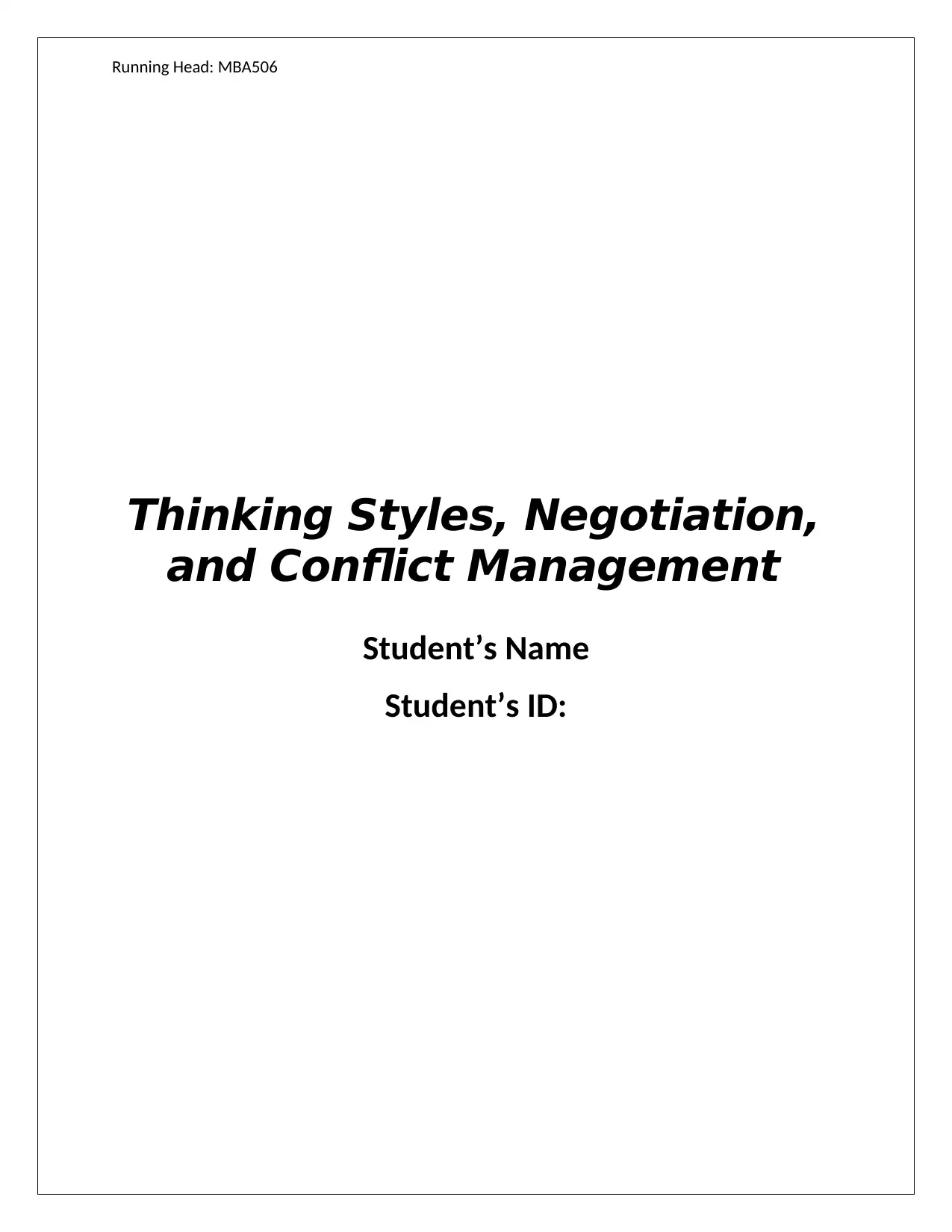
Running Head: MBA506
Thinking Styles, Negotiation,
and Conflict Management
Student’s Name
Student’s ID:
Thinking Styles, Negotiation,
and Conflict Management
Student’s Name
Student’s ID:
Paraphrase This Document
Need a fresh take? Get an instant paraphrase of this document with our AI Paraphraser
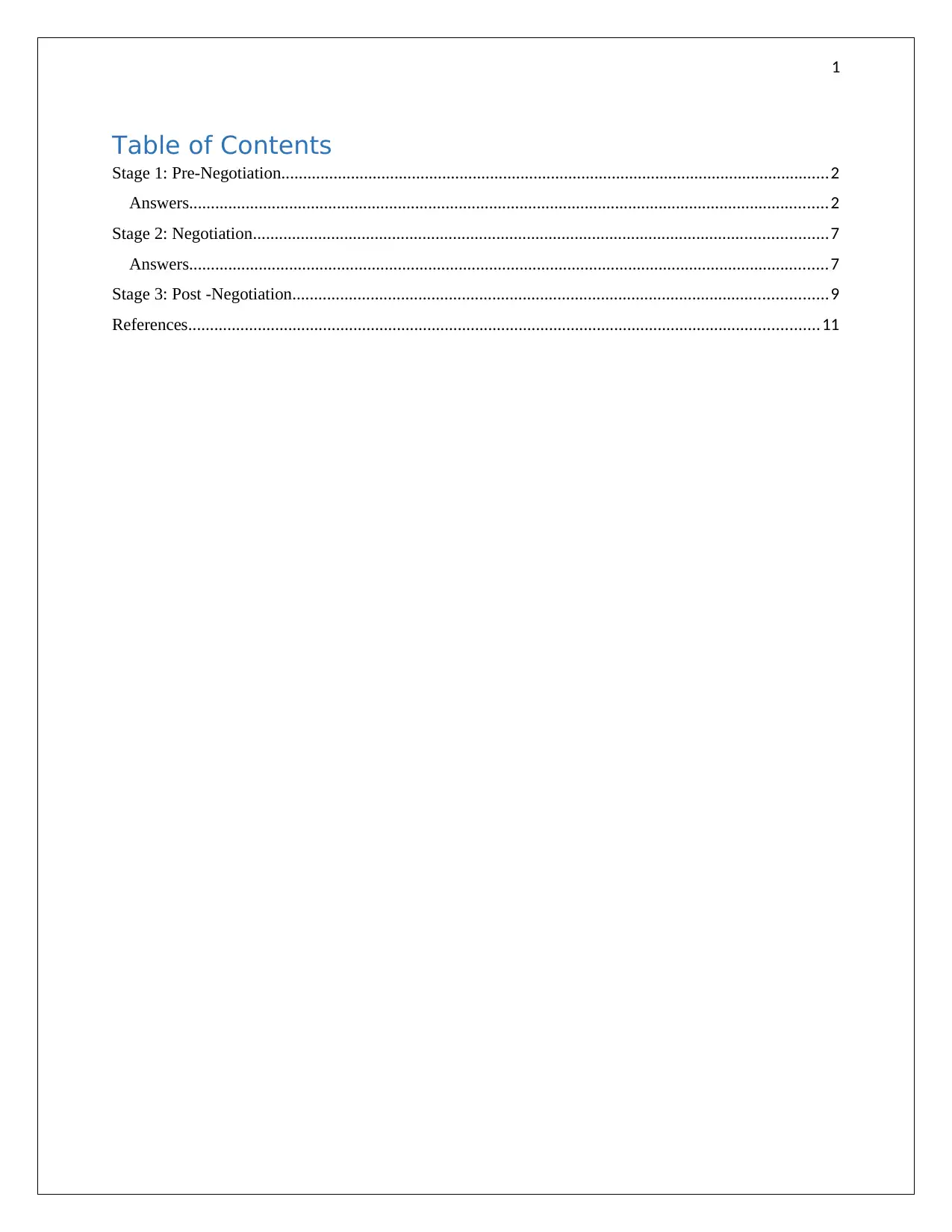
1
Table of Contents
Stage 1: Pre-Negotiation..............................................................................................................................2
Answers...................................................................................................................................................2
Stage 2: Negotiation....................................................................................................................................7
Answers...................................................................................................................................................7
Stage 3: Post -Negotiation...........................................................................................................................9
References.................................................................................................................................................11
Table of Contents
Stage 1: Pre-Negotiation..............................................................................................................................2
Answers...................................................................................................................................................2
Stage 2: Negotiation....................................................................................................................................7
Answers...................................................................................................................................................7
Stage 3: Post -Negotiation...........................................................................................................................9
References.................................................................................................................................................11
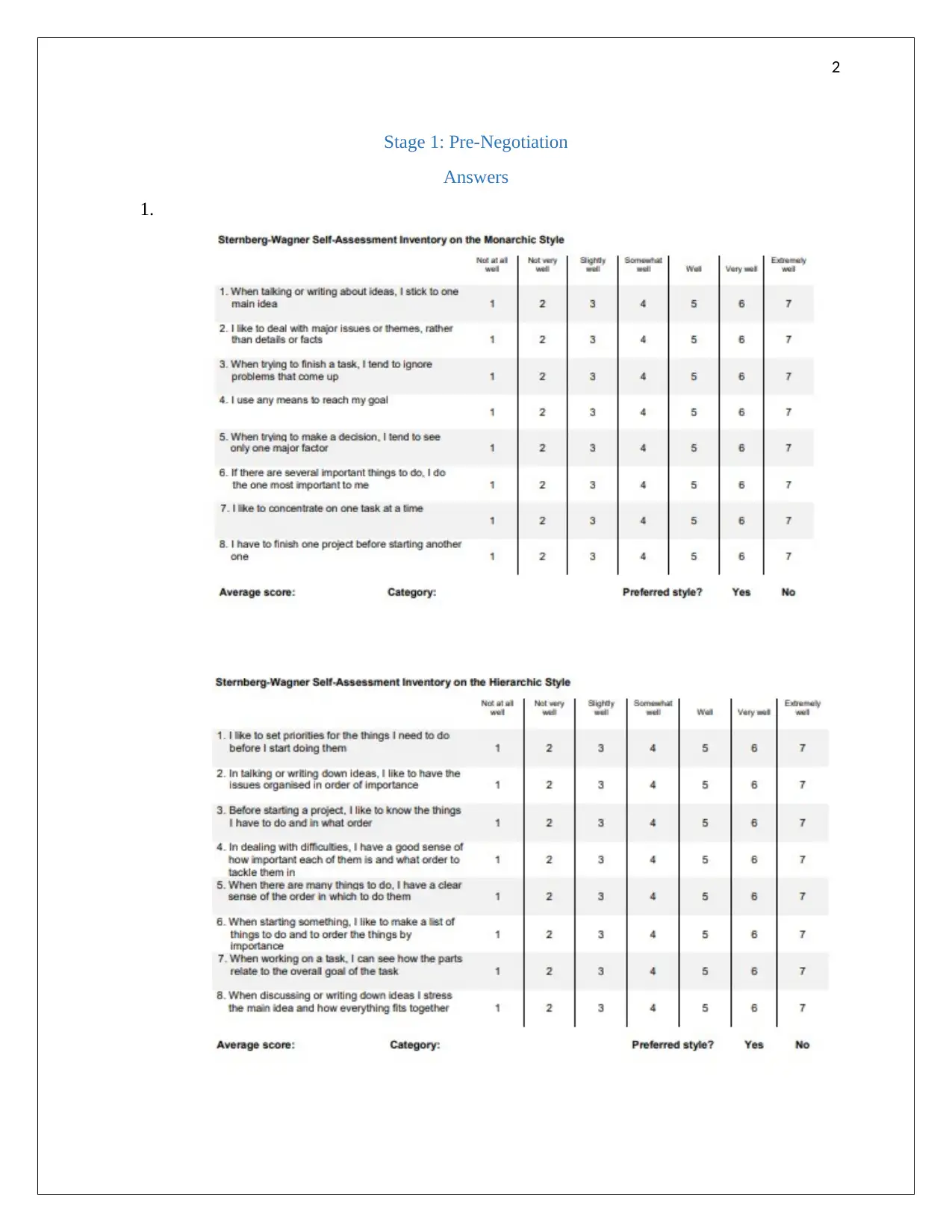
2
Stage 1: Pre-Negotiation
Answers
1.
Stage 1: Pre-Negotiation
Answers
1.
⊘ This is a preview!⊘
Do you want full access?
Subscribe today to unlock all pages.

Trusted by 1+ million students worldwide
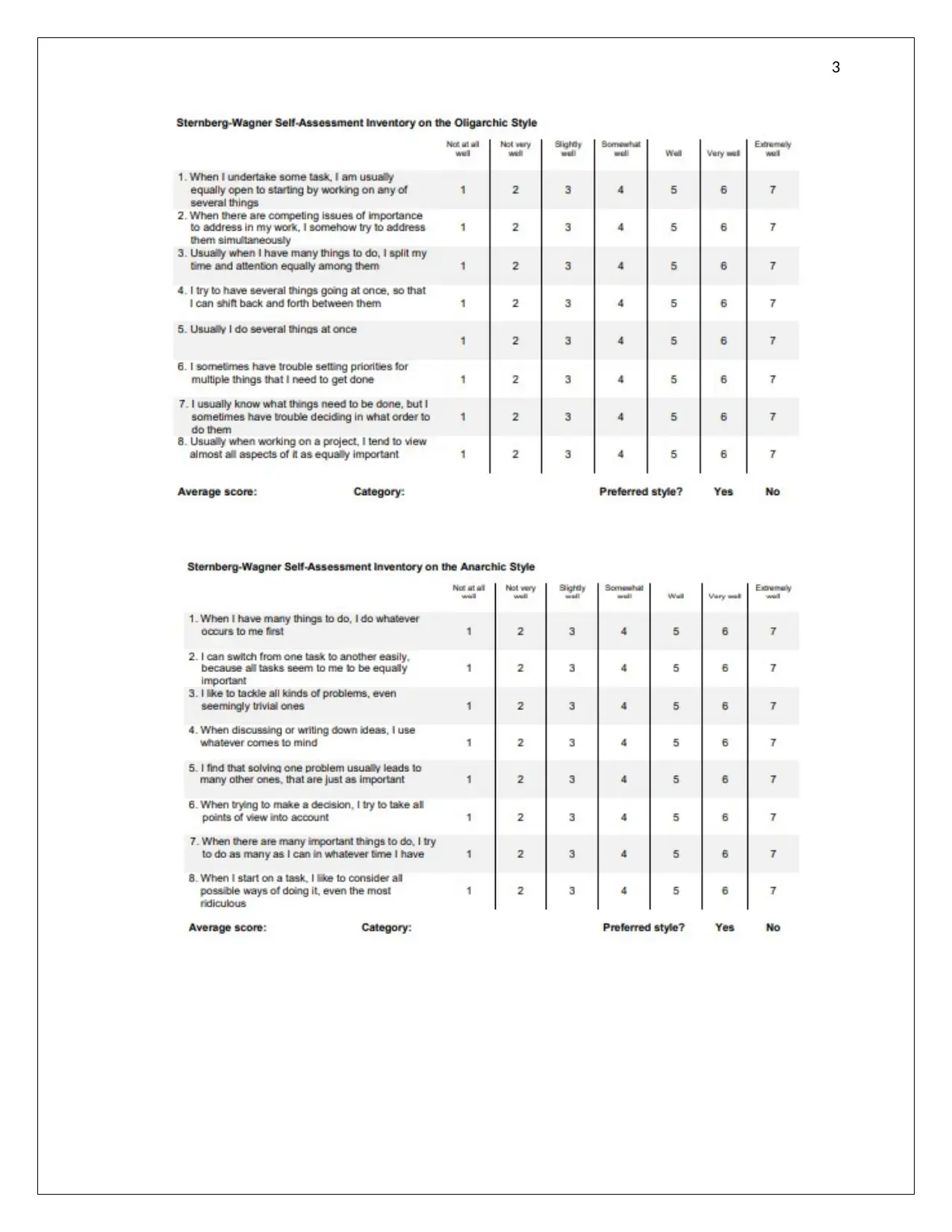
3
Paraphrase This Document
Need a fresh take? Get an instant paraphrase of this document with our AI Paraphraser
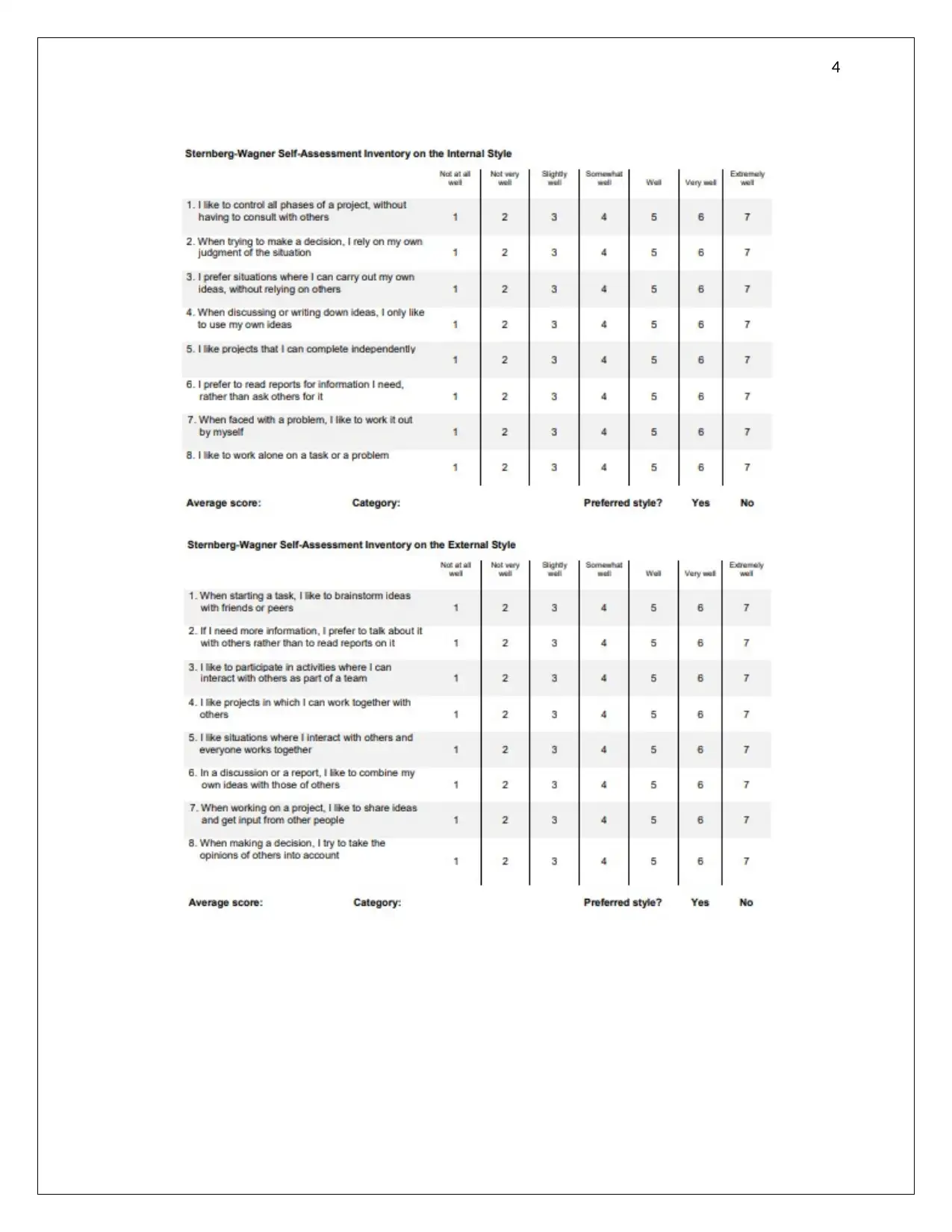
4
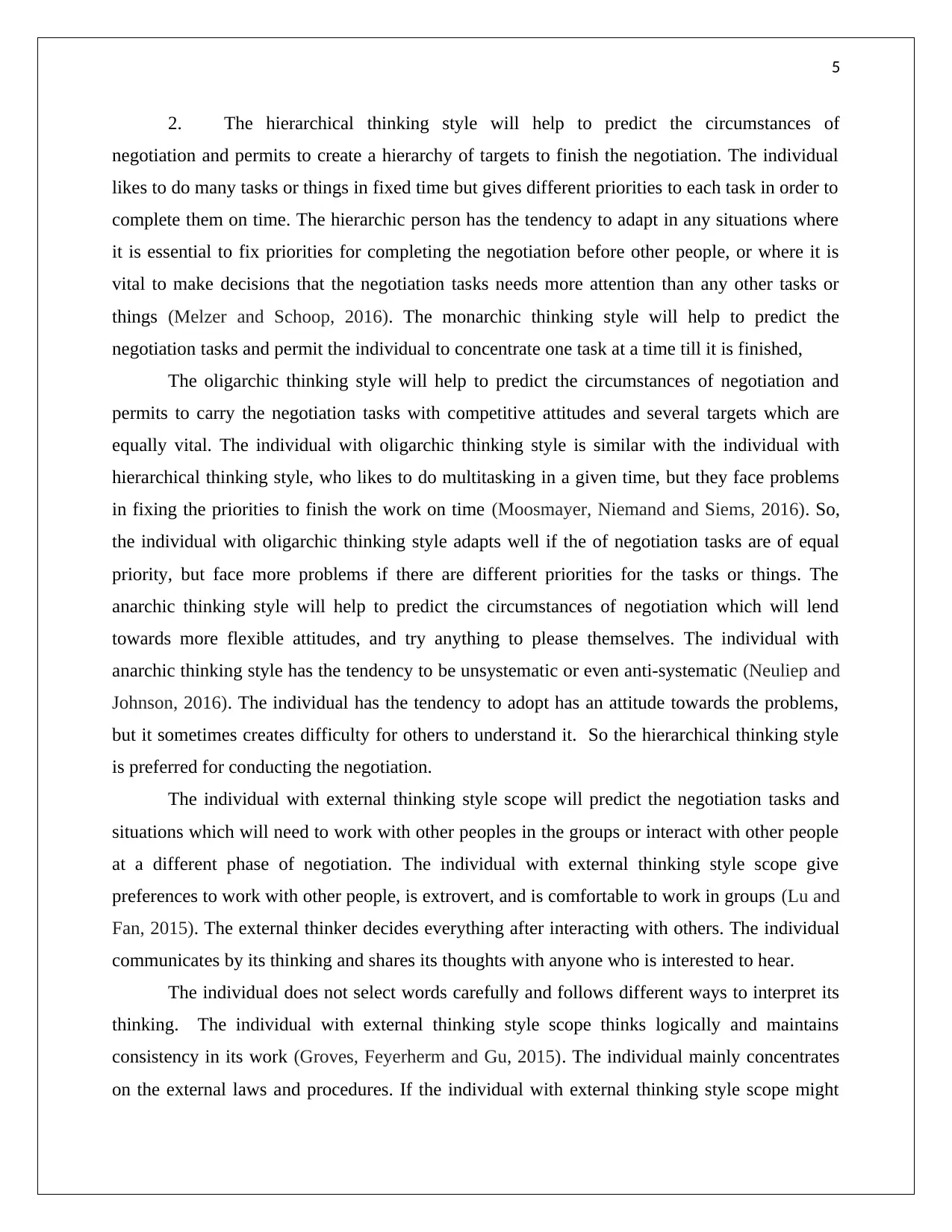
5
2. The hierarchical thinking style will help to predict the circumstances of
negotiation and permits to create a hierarchy of targets to finish the negotiation. The individual
likes to do many tasks or things in fixed time but gives different priorities to each task in order to
complete them on time. The hierarchic person has the tendency to adapt in any situations where
it is essential to fix priorities for completing the negotiation before other people, or where it is
vital to make decisions that the negotiation tasks needs more attention than any other tasks or
things (Melzer and Schoop, 2016). The monarchic thinking style will help to predict the
negotiation tasks and permit the individual to concentrate one task at a time till it is finished,
The oligarchic thinking style will help to predict the circumstances of negotiation and
permits to carry the negotiation tasks with competitive attitudes and several targets which are
equally vital. The individual with oligarchic thinking style is similar with the individual with
hierarchical thinking style, who likes to do multitasking in a given time, but they face problems
in fixing the priorities to finish the work on time (Moosmayer, Niemand and Siems, 2016). So,
the individual with oligarchic thinking style adapts well if the of negotiation tasks are of equal
priority, but face more problems if there are different priorities for the tasks or things. The
anarchic thinking style will help to predict the circumstances of negotiation which will lend
towards more flexible attitudes, and try anything to please themselves. The individual with
anarchic thinking style has the tendency to be unsystematic or even anti-systematic (Neuliep and
Johnson, 2016). The individual has the tendency to adopt has an attitude towards the problems,
but it sometimes creates difficulty for others to understand it. So the hierarchical thinking style
is preferred for conducting the negotiation.
The individual with external thinking style scope will predict the negotiation tasks and
situations which will need to work with other peoples in the groups or interact with other people
at a different phase of negotiation. The individual with external thinking style scope give
preferences to work with other people, is extrovert, and is comfortable to work in groups (Lu and
Fan, 2015). The external thinker decides everything after interacting with others. The individual
communicates by its thinking and shares its thoughts with anyone who is interested to hear.
The individual does not select words carefully and follows different ways to interpret its
thinking. The individual with external thinking style scope thinks logically and maintains
consistency in its work (Groves, Feyerherm and Gu, 2015). The individual mainly concentrates
on the external laws and procedures. If the individual with external thinking style scope might
2. The hierarchical thinking style will help to predict the circumstances of
negotiation and permits to create a hierarchy of targets to finish the negotiation. The individual
likes to do many tasks or things in fixed time but gives different priorities to each task in order to
complete them on time. The hierarchic person has the tendency to adapt in any situations where
it is essential to fix priorities for completing the negotiation before other people, or where it is
vital to make decisions that the negotiation tasks needs more attention than any other tasks or
things (Melzer and Schoop, 2016). The monarchic thinking style will help to predict the
negotiation tasks and permit the individual to concentrate one task at a time till it is finished,
The oligarchic thinking style will help to predict the circumstances of negotiation and
permits to carry the negotiation tasks with competitive attitudes and several targets which are
equally vital. The individual with oligarchic thinking style is similar with the individual with
hierarchical thinking style, who likes to do multitasking in a given time, but they face problems
in fixing the priorities to finish the work on time (Moosmayer, Niemand and Siems, 2016). So,
the individual with oligarchic thinking style adapts well if the of negotiation tasks are of equal
priority, but face more problems if there are different priorities for the tasks or things. The
anarchic thinking style will help to predict the circumstances of negotiation which will lend
towards more flexible attitudes, and try anything to please themselves. The individual with
anarchic thinking style has the tendency to be unsystematic or even anti-systematic (Neuliep and
Johnson, 2016). The individual has the tendency to adopt has an attitude towards the problems,
but it sometimes creates difficulty for others to understand it. So the hierarchical thinking style
is preferred for conducting the negotiation.
The individual with external thinking style scope will predict the negotiation tasks and
situations which will need to work with other peoples in the groups or interact with other people
at a different phase of negotiation. The individual with external thinking style scope give
preferences to work with other people, is extrovert, and is comfortable to work in groups (Lu and
Fan, 2015). The external thinker decides everything after interacting with others. The individual
communicates by its thinking and shares its thoughts with anyone who is interested to hear.
The individual does not select words carefully and follows different ways to interpret its
thinking. The individual with external thinking style scope thinks logically and maintains
consistency in its work (Groves, Feyerherm and Gu, 2015). The individual mainly concentrates
on the external laws and procedures. If the individual with external thinking style scope might
⊘ This is a preview!⊘
Do you want full access?
Subscribe today to unlock all pages.

Trusted by 1+ million students worldwide
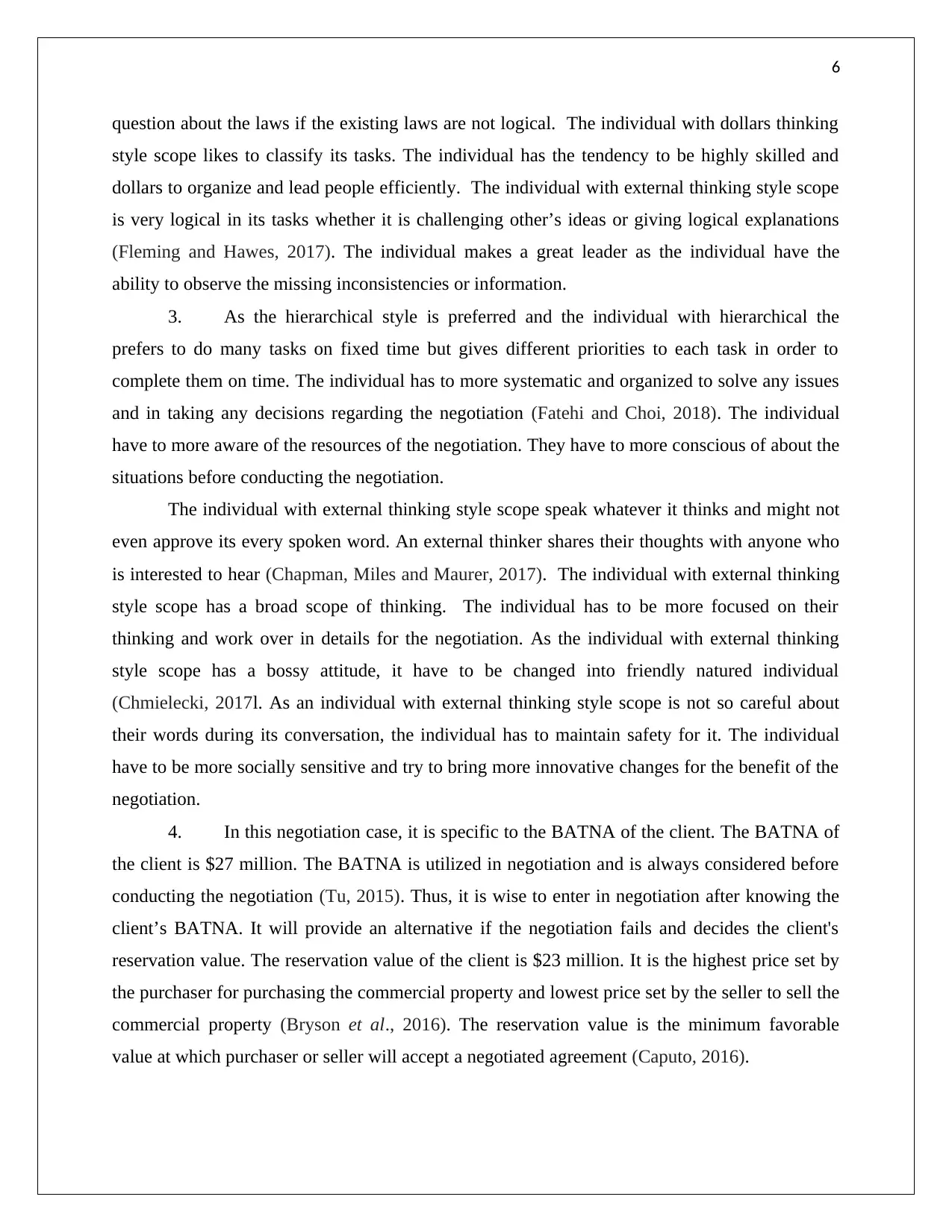
6
question about the laws if the existing laws are not logical. The individual with dollars thinking
style scope likes to classify its tasks. The individual has the tendency to be highly skilled and
dollars to organize and lead people efficiently. The individual with external thinking style scope
is very logical in its tasks whether it is challenging other’s ideas or giving logical explanations
(Fleming and Hawes, 2017). The individual makes a great leader as the individual have the
ability to observe the missing inconsistencies or information.
3. As the hierarchical style is preferred and the individual with hierarchical the
prefers to do many tasks on fixed time but gives different priorities to each task in order to
complete them on time. The individual has to more systematic and organized to solve any issues
and in taking any decisions regarding the negotiation (Fatehi and Choi, 2018). The individual
have to more aware of the resources of the negotiation. They have to more conscious of about the
situations before conducting the negotiation.
The individual with external thinking style scope speak whatever it thinks and might not
even approve its every spoken word. An external thinker shares their thoughts with anyone who
is interested to hear (Chapman, Miles and Maurer, 2017). The individual with external thinking
style scope has a broad scope of thinking. The individual has to be more focused on their
thinking and work over in details for the negotiation. As the individual with external thinking
style scope has a bossy attitude, it have to be changed into friendly natured individual
(Chmielecki, 2017l. As an individual with external thinking style scope is not so careful about
their words during its conversation, the individual has to maintain safety for it. The individual
have to be more socially sensitive and try to bring more innovative changes for the benefit of the
negotiation.
4. In this negotiation case, it is specific to the BATNA of the client. The BATNA of
the client is $27 million. The BATNA is utilized in negotiation and is always considered before
conducting the negotiation (Tu, 2015). Thus, it is wise to enter in negotiation after knowing the
client’s BATNA. It will provide an alternative if the negotiation fails and decides the client's
reservation value. The reservation value of the client is $23 million. It is the highest price set by
the purchaser for purchasing the commercial property and lowest price set by the seller to sell the
commercial property (Bryson et al., 2016). The reservation value is the minimum favorable
value at which purchaser or seller will accept a negotiated agreement (Caputo, 2016).
question about the laws if the existing laws are not logical. The individual with dollars thinking
style scope likes to classify its tasks. The individual has the tendency to be highly skilled and
dollars to organize and lead people efficiently. The individual with external thinking style scope
is very logical in its tasks whether it is challenging other’s ideas or giving logical explanations
(Fleming and Hawes, 2017). The individual makes a great leader as the individual have the
ability to observe the missing inconsistencies or information.
3. As the hierarchical style is preferred and the individual with hierarchical the
prefers to do many tasks on fixed time but gives different priorities to each task in order to
complete them on time. The individual has to more systematic and organized to solve any issues
and in taking any decisions regarding the negotiation (Fatehi and Choi, 2018). The individual
have to more aware of the resources of the negotiation. They have to more conscious of about the
situations before conducting the negotiation.
The individual with external thinking style scope speak whatever it thinks and might not
even approve its every spoken word. An external thinker shares their thoughts with anyone who
is interested to hear (Chapman, Miles and Maurer, 2017). The individual with external thinking
style scope has a broad scope of thinking. The individual has to be more focused on their
thinking and work over in details for the negotiation. As the individual with external thinking
style scope has a bossy attitude, it have to be changed into friendly natured individual
(Chmielecki, 2017l. As an individual with external thinking style scope is not so careful about
their words during its conversation, the individual has to maintain safety for it. The individual
have to be more socially sensitive and try to bring more innovative changes for the benefit of the
negotiation.
4. In this negotiation case, it is specific to the BATNA of the client. The BATNA of
the client is $27 million. The BATNA is utilized in negotiation and is always considered before
conducting the negotiation (Tu, 2015). Thus, it is wise to enter in negotiation after knowing the
client’s BATNA. It will provide an alternative if the negotiation fails and decides the client's
reservation value. The reservation value of the client is $23 million. It is the highest price set by
the purchaser for purchasing the commercial property and lowest price set by the seller to sell the
commercial property (Bryson et al., 2016). The reservation value is the minimum favorable
value at which purchaser or seller will accept a negotiated agreement (Caputo, 2016).
Paraphrase This Document
Need a fresh take? Get an instant paraphrase of this document with our AI Paraphraser
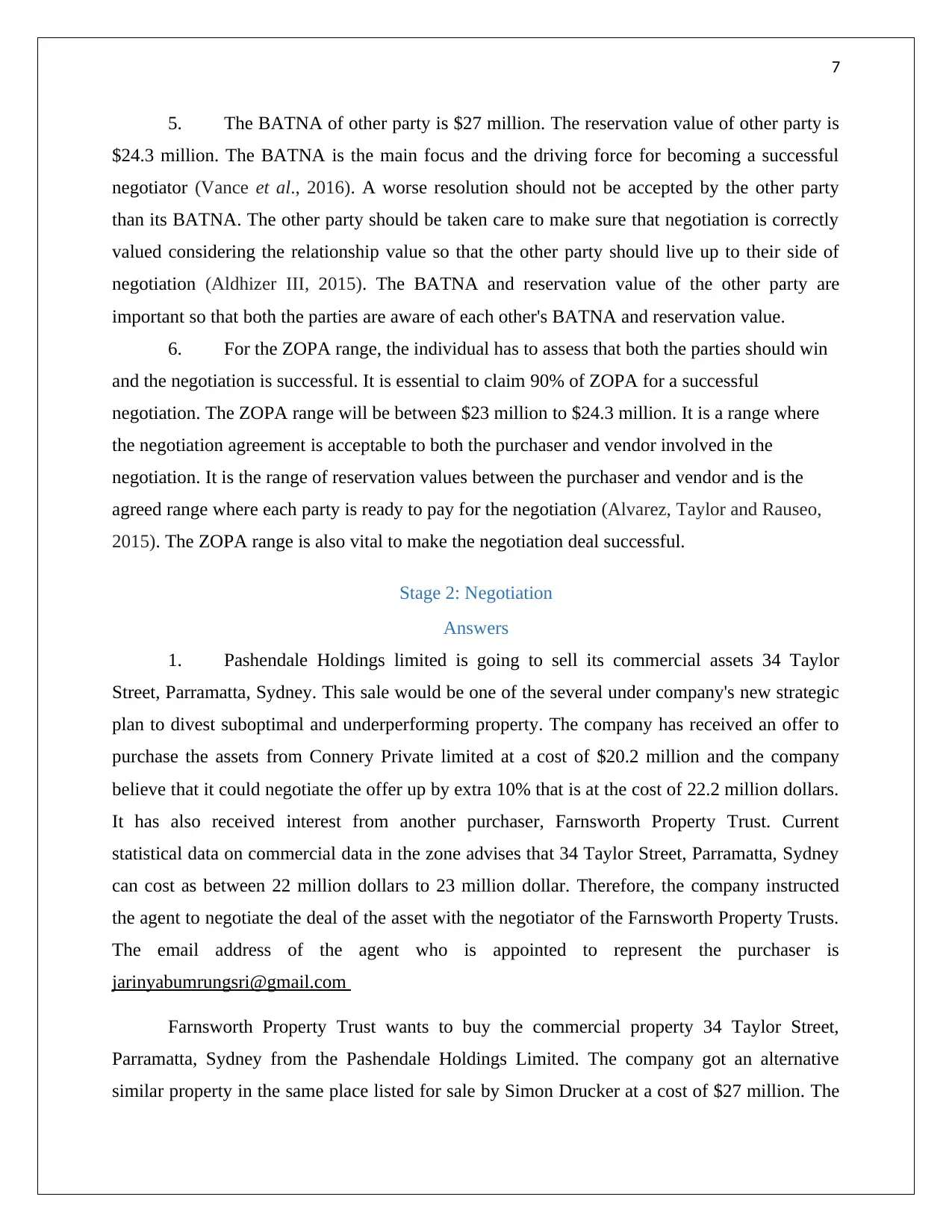
7
5. The BATNA of other party is $27 million. The reservation value of other party is
$24.3 million. The BATNA is the main focus and the driving force for becoming a successful
negotiator (Vance et al., 2016). A worse resolution should not be accepted by the other party
than its BATNA. The other party should be taken care to make sure that negotiation is correctly
valued considering the relationship value so that the other party should live up to their side of
negotiation (Aldhizer III, 2015). The BATNA and reservation value of the other party are
important so that both the parties are aware of each other's BATNA and reservation value.
6. For the ZOPA range, the individual has to assess that both the parties should win
and the negotiation is successful. It is essential to claim 90% of ZOPA for a successful
negotiation. The ZOPA range will be between $23 million to $24.3 million. It is a range where
the negotiation agreement is acceptable to both the purchaser and vendor involved in the
negotiation. It is the range of reservation values between the purchaser and vendor and is the
agreed range where each party is ready to pay for the negotiation (Alvarez, Taylor and Rauseo,
2015). The ZOPA range is also vital to make the negotiation deal successful.
Stage 2: Negotiation
Answers
1. Pashendale Holdings limited is going to sell its commercial assets 34 Taylor
Street, Parramatta, Sydney. This sale would be one of the several under company's new strategic
plan to divest suboptimal and underperforming property. The company has received an offer to
purchase the assets from Connery Private limited at a cost of $20.2 million and the company
believe that it could negotiate the offer up by extra 10% that is at the cost of 22.2 million dollars.
It has also received interest from another purchaser, Farnsworth Property Trust. Current
statistical data on commercial data in the zone advises that 34 Taylor Street, Parramatta, Sydney
can cost as between 22 million dollars to 23 million dollar. Therefore, the company instructed
the agent to negotiate the deal of the asset with the negotiator of the Farnsworth Property Trusts.
The email address of the agent who is appointed to represent the purchaser is
jarinyabumrungsri@gmail.com
Farnsworth Property Trust wants to buy the commercial property 34 Taylor Street,
Parramatta, Sydney from the Pashendale Holdings Limited. The company got an alternative
similar property in the same place listed for sale by Simon Drucker at a cost of $27 million. The
5. The BATNA of other party is $27 million. The reservation value of other party is
$24.3 million. The BATNA is the main focus and the driving force for becoming a successful
negotiator (Vance et al., 2016). A worse resolution should not be accepted by the other party
than its BATNA. The other party should be taken care to make sure that negotiation is correctly
valued considering the relationship value so that the other party should live up to their side of
negotiation (Aldhizer III, 2015). The BATNA and reservation value of the other party are
important so that both the parties are aware of each other's BATNA and reservation value.
6. For the ZOPA range, the individual has to assess that both the parties should win
and the negotiation is successful. It is essential to claim 90% of ZOPA for a successful
negotiation. The ZOPA range will be between $23 million to $24.3 million. It is a range where
the negotiation agreement is acceptable to both the purchaser and vendor involved in the
negotiation. It is the range of reservation values between the purchaser and vendor and is the
agreed range where each party is ready to pay for the negotiation (Alvarez, Taylor and Rauseo,
2015). The ZOPA range is also vital to make the negotiation deal successful.
Stage 2: Negotiation
Answers
1. Pashendale Holdings limited is going to sell its commercial assets 34 Taylor
Street, Parramatta, Sydney. This sale would be one of the several under company's new strategic
plan to divest suboptimal and underperforming property. The company has received an offer to
purchase the assets from Connery Private limited at a cost of $20.2 million and the company
believe that it could negotiate the offer up by extra 10% that is at the cost of 22.2 million dollars.
It has also received interest from another purchaser, Farnsworth Property Trust. Current
statistical data on commercial data in the zone advises that 34 Taylor Street, Parramatta, Sydney
can cost as between 22 million dollars to 23 million dollar. Therefore, the company instructed
the agent to negotiate the deal of the asset with the negotiator of the Farnsworth Property Trusts.
The email address of the agent who is appointed to represent the purchaser is
jarinyabumrungsri@gmail.com
Farnsworth Property Trust wants to buy the commercial property 34 Taylor Street,
Parramatta, Sydney from the Pashendale Holdings Limited. The company got an alternative
similar property in the same place listed for sale by Simon Drucker at a cost of $27 million. The
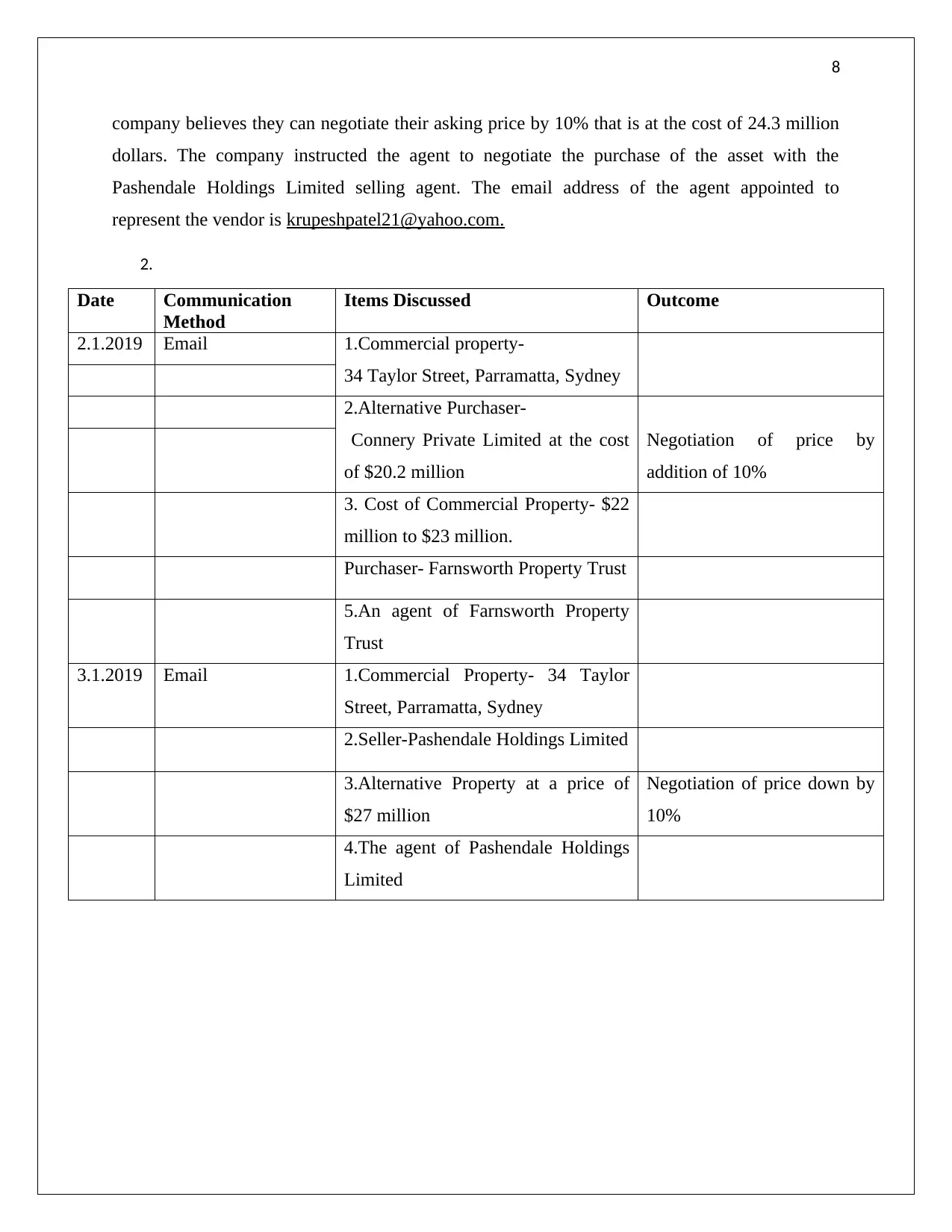
8
company believes they can negotiate their asking price by 10% that is at the cost of 24.3 million
dollars. The company instructed the agent to negotiate the purchase of the asset with the
Pashendale Holdings Limited selling agent. The email address of the agent appointed to
represent the vendor is krupeshpatel21@yahoo.com.
2.
Date Communication
Method
Items Discussed Outcome
2.1.2019 Email 1.Commercial property-
34 Taylor Street, Parramatta, Sydney
2.Alternative Purchaser-
Connery Private Limited at the cost
of $20.2 million
Negotiation of price by
addition of 10%
3. Cost of Commercial Property- $22
million to $23 million.
Purchaser- Farnsworth Property Trust
5.An agent of Farnsworth Property
Trust
3.1.2019 Email 1.Commercial Property- 34 Taylor
Street, Parramatta, Sydney
2.Seller-Pashendale Holdings Limited
3.Alternative Property at a price of
$27 million
Negotiation of price down by
10%
4.The agent of Pashendale Holdings
Limited
company believes they can negotiate their asking price by 10% that is at the cost of 24.3 million
dollars. The company instructed the agent to negotiate the purchase of the asset with the
Pashendale Holdings Limited selling agent. The email address of the agent appointed to
represent the vendor is krupeshpatel21@yahoo.com.
2.
Date Communication
Method
Items Discussed Outcome
2.1.2019 Email 1.Commercial property-
34 Taylor Street, Parramatta, Sydney
2.Alternative Purchaser-
Connery Private Limited at the cost
of $20.2 million
Negotiation of price by
addition of 10%
3. Cost of Commercial Property- $22
million to $23 million.
Purchaser- Farnsworth Property Trust
5.An agent of Farnsworth Property
Trust
3.1.2019 Email 1.Commercial Property- 34 Taylor
Street, Parramatta, Sydney
2.Seller-Pashendale Holdings Limited
3.Alternative Property at a price of
$27 million
Negotiation of price down by
10%
4.The agent of Pashendale Holdings
Limited
⊘ This is a preview!⊘
Do you want full access?
Subscribe today to unlock all pages.

Trusted by 1+ million students worldwide
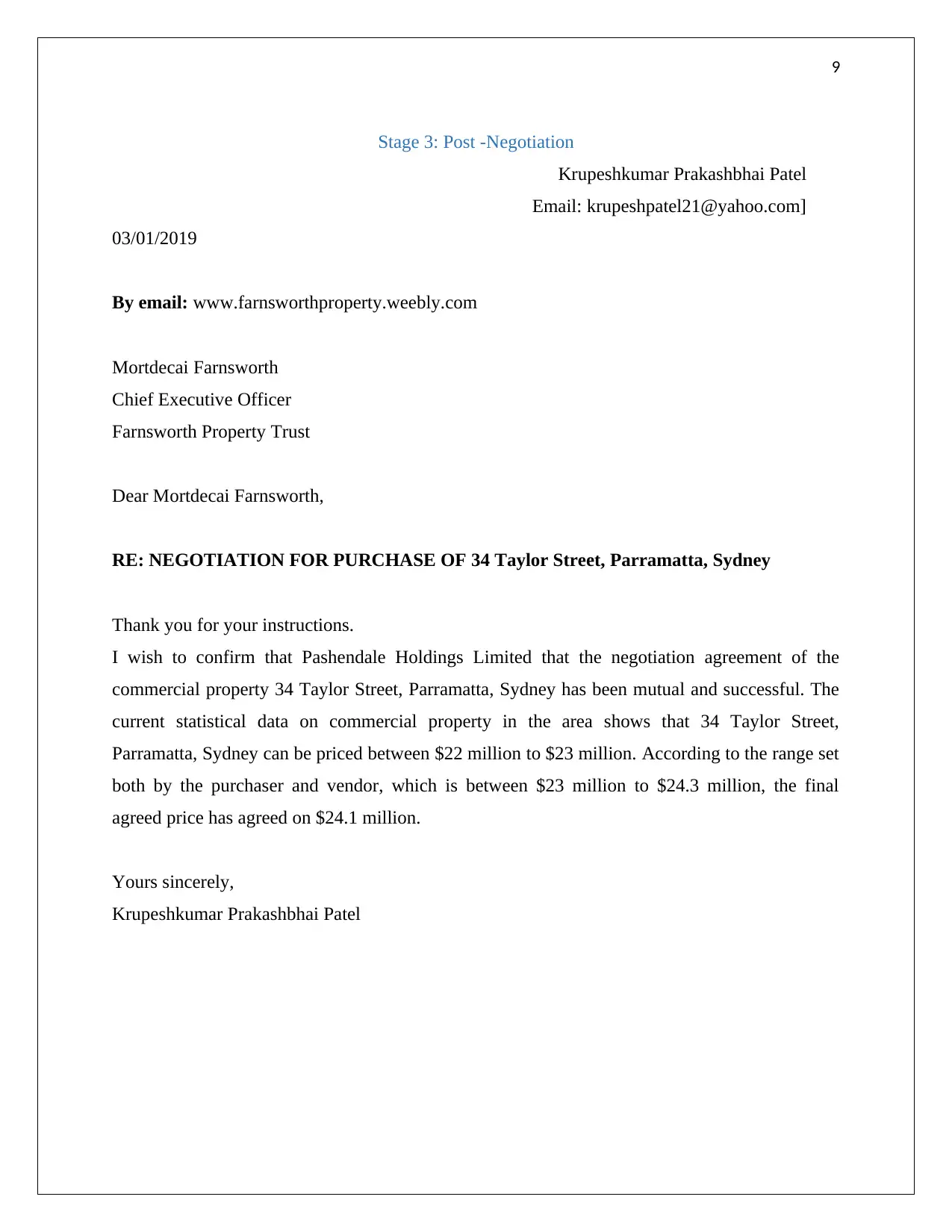
9
Stage 3: Post -Negotiation
Krupeshkumar Prakashbhai Patel
Email: krupeshpatel21@yahoo.com]
03/01/2019
By email: www.farnsworthproperty.weebly.com
Mortdecai Farnsworth
Chief Executive Officer
Farnsworth Property Trust
Dear Mortdecai Farnsworth,
RE: NEGOTIATION FOR PURCHASE OF 34 Taylor Street, Parramatta, Sydney
Thank you for your instructions.
I wish to confirm that Pashendale Holdings Limited that the negotiation agreement of the
commercial property 34 Taylor Street, Parramatta, Sydney has been mutual and successful. The
current statistical data on commercial property in the area shows that 34 Taylor Street,
Parramatta, Sydney can be priced between $22 million to $23 million. According to the range set
both by the purchaser and vendor, which is between $23 million to $24.3 million, the final
agreed price has agreed on $24.1 million.
Yours sincerely,
Krupeshkumar Prakashbhai Patel
Stage 3: Post -Negotiation
Krupeshkumar Prakashbhai Patel
Email: krupeshpatel21@yahoo.com]
03/01/2019
By email: www.farnsworthproperty.weebly.com
Mortdecai Farnsworth
Chief Executive Officer
Farnsworth Property Trust
Dear Mortdecai Farnsworth,
RE: NEGOTIATION FOR PURCHASE OF 34 Taylor Street, Parramatta, Sydney
Thank you for your instructions.
I wish to confirm that Pashendale Holdings Limited that the negotiation agreement of the
commercial property 34 Taylor Street, Parramatta, Sydney has been mutual and successful. The
current statistical data on commercial property in the area shows that 34 Taylor Street,
Parramatta, Sydney can be priced between $22 million to $23 million. According to the range set
both by the purchaser and vendor, which is between $23 million to $24.3 million, the final
agreed price has agreed on $24.1 million.
Yours sincerely,
Krupeshkumar Prakashbhai Patel
Paraphrase This Document
Need a fresh take? Get an instant paraphrase of this document with our AI Paraphraser
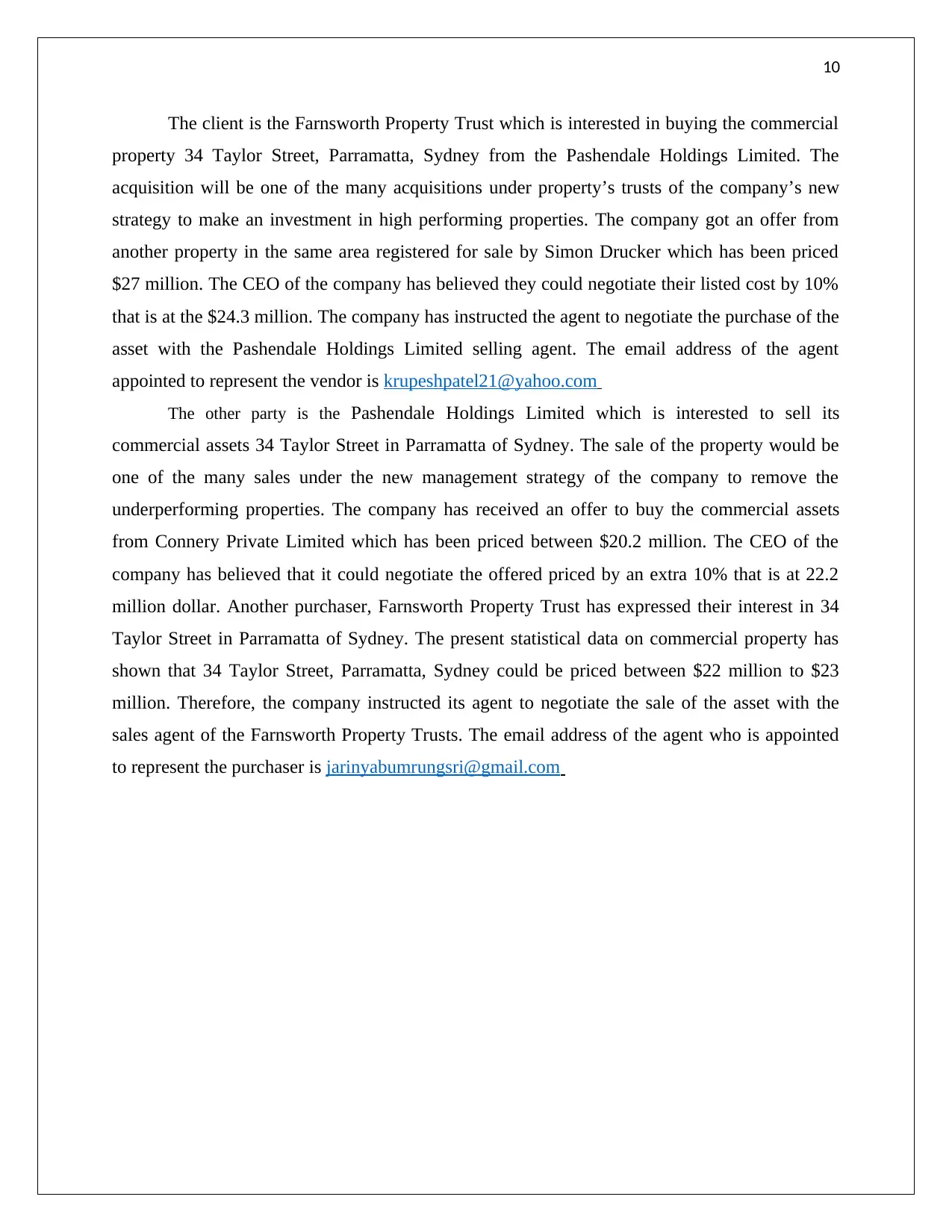
10
The client is the Farnsworth Property Trust which is interested in buying the commercial
property 34 Taylor Street, Parramatta, Sydney from the Pashendale Holdings Limited. The
acquisition will be one of the many acquisitions under property’s trusts of the company’s new
strategy to make an investment in high performing properties. The company got an offer from
another property in the same area registered for sale by Simon Drucker which has been priced
$27 million. The CEO of the company has believed they could negotiate their listed cost by 10%
that is at the $24.3 million. The company has instructed the agent to negotiate the purchase of the
asset with the Pashendale Holdings Limited selling agent. The email address of the agent
appointed to represent the vendor is krupeshpatel21@yahoo.com
The other party is the Pashendale Holdings Limited which is interested to sell its
commercial assets 34 Taylor Street in Parramatta of Sydney. The sale of the property would be
one of the many sales under the new management strategy of the company to remove the
underperforming properties. The company has received an offer to buy the commercial assets
from Connery Private Limited which has been priced between $20.2 million. The CEO of the
company has believed that it could negotiate the offered priced by an extra 10% that is at 22.2
million dollar. Another purchaser, Farnsworth Property Trust has expressed their interest in 34
Taylor Street in Parramatta of Sydney. The present statistical data on commercial property has
shown that 34 Taylor Street, Parramatta, Sydney could be priced between $22 million to $23
million. Therefore, the company instructed its agent to negotiate the sale of the asset with the
sales agent of the Farnsworth Property Trusts. The email address of the agent who is appointed
to represent the purchaser is jarinyabumrungsri@gmail.com
The client is the Farnsworth Property Trust which is interested in buying the commercial
property 34 Taylor Street, Parramatta, Sydney from the Pashendale Holdings Limited. The
acquisition will be one of the many acquisitions under property’s trusts of the company’s new
strategy to make an investment in high performing properties. The company got an offer from
another property in the same area registered for sale by Simon Drucker which has been priced
$27 million. The CEO of the company has believed they could negotiate their listed cost by 10%
that is at the $24.3 million. The company has instructed the agent to negotiate the purchase of the
asset with the Pashendale Holdings Limited selling agent. The email address of the agent
appointed to represent the vendor is krupeshpatel21@yahoo.com
The other party is the Pashendale Holdings Limited which is interested to sell its
commercial assets 34 Taylor Street in Parramatta of Sydney. The sale of the property would be
one of the many sales under the new management strategy of the company to remove the
underperforming properties. The company has received an offer to buy the commercial assets
from Connery Private Limited which has been priced between $20.2 million. The CEO of the
company has believed that it could negotiate the offered priced by an extra 10% that is at 22.2
million dollar. Another purchaser, Farnsworth Property Trust has expressed their interest in 34
Taylor Street in Parramatta of Sydney. The present statistical data on commercial property has
shown that 34 Taylor Street, Parramatta, Sydney could be priced between $22 million to $23
million. Therefore, the company instructed its agent to negotiate the sale of the asset with the
sales agent of the Farnsworth Property Trusts. The email address of the agent who is appointed
to represent the purchaser is jarinyabumrungsri@gmail.com
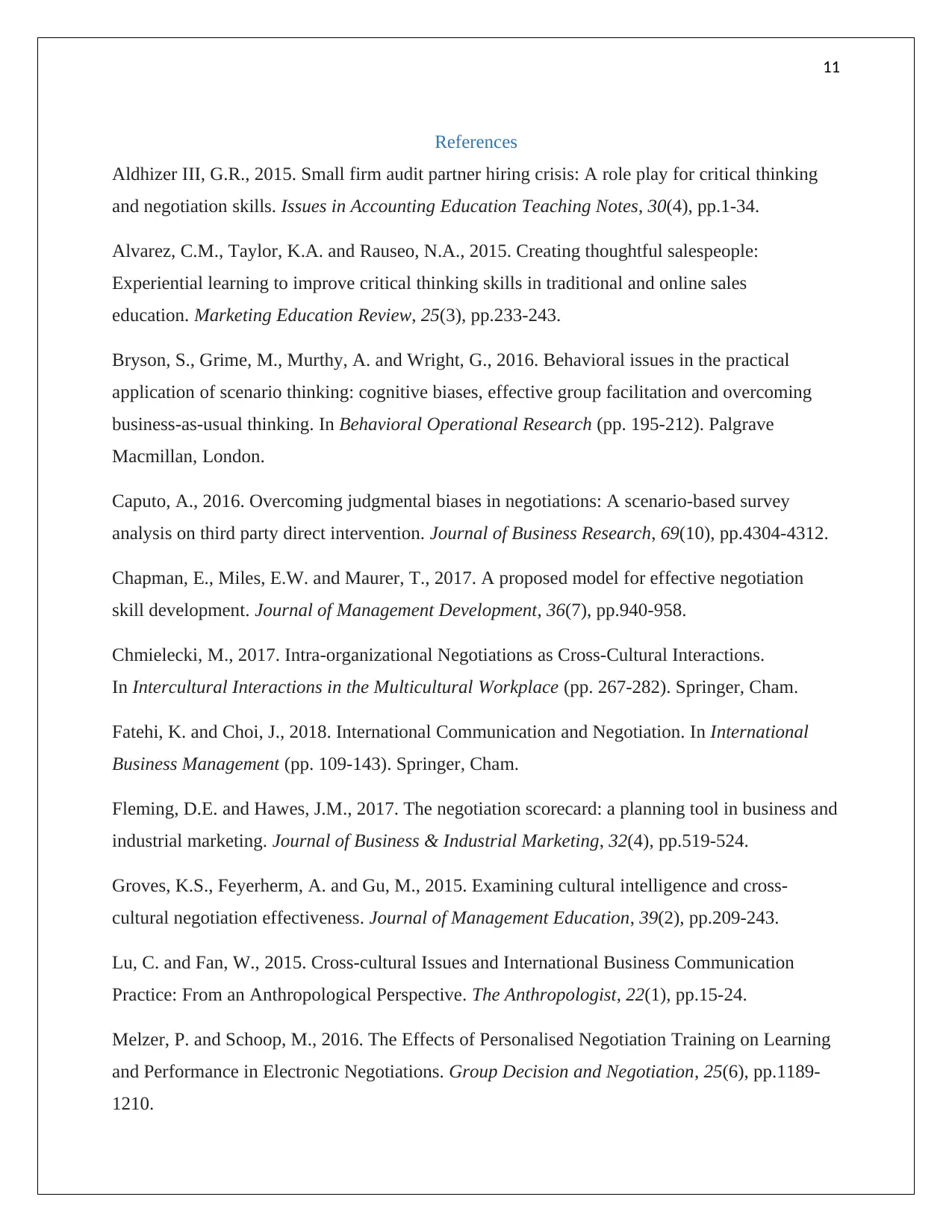
11
References
Aldhizer III, G.R., 2015. Small firm audit partner hiring crisis: A role play for critical thinking
and negotiation skills. Issues in Accounting Education Teaching Notes, 30(4), pp.1-34.
Alvarez, C.M., Taylor, K.A. and Rauseo, N.A., 2015. Creating thoughtful salespeople:
Experiential learning to improve critical thinking skills in traditional and online sales
education. Marketing Education Review, 25(3), pp.233-243.
Bryson, S., Grime, M., Murthy, A. and Wright, G., 2016. Behavioral issues in the practical
application of scenario thinking: cognitive biases, effective group facilitation and overcoming
business-as-usual thinking. In Behavioral Operational Research (pp. 195-212). Palgrave
Macmillan, London.
Caputo, A., 2016. Overcoming judgmental biases in negotiations: A scenario-based survey
analysis on third party direct intervention. Journal of Business Research, 69(10), pp.4304-4312.
Chapman, E., Miles, E.W. and Maurer, T., 2017. A proposed model for effective negotiation
skill development. Journal of Management Development, 36(7), pp.940-958.
Chmielecki, M., 2017. Intra-organizational Negotiations as Cross-Cultural Interactions.
In Intercultural Interactions in the Multicultural Workplace (pp. 267-282). Springer, Cham.
Fatehi, K. and Choi, J., 2018. International Communication and Negotiation. In International
Business Management (pp. 109-143). Springer, Cham.
Fleming, D.E. and Hawes, J.M., 2017. The negotiation scorecard: a planning tool in business and
industrial marketing. Journal of Business & Industrial Marketing, 32(4), pp.519-524.
Groves, K.S., Feyerherm, A. and Gu, M., 2015. Examining cultural intelligence and cross-
cultural negotiation effectiveness. Journal of Management Education, 39(2), pp.209-243.
Lu, C. and Fan, W., 2015. Cross-cultural Issues and International Business Communication
Practice: From an Anthropological Perspective. The Anthropologist, 22(1), pp.15-24.
Melzer, P. and Schoop, M., 2016. The Effects of Personalised Negotiation Training on Learning
and Performance in Electronic Negotiations. Group Decision and Negotiation, 25(6), pp.1189-
1210.
References
Aldhizer III, G.R., 2015. Small firm audit partner hiring crisis: A role play for critical thinking
and negotiation skills. Issues in Accounting Education Teaching Notes, 30(4), pp.1-34.
Alvarez, C.M., Taylor, K.A. and Rauseo, N.A., 2015. Creating thoughtful salespeople:
Experiential learning to improve critical thinking skills in traditional and online sales
education. Marketing Education Review, 25(3), pp.233-243.
Bryson, S., Grime, M., Murthy, A. and Wright, G., 2016. Behavioral issues in the practical
application of scenario thinking: cognitive biases, effective group facilitation and overcoming
business-as-usual thinking. In Behavioral Operational Research (pp. 195-212). Palgrave
Macmillan, London.
Caputo, A., 2016. Overcoming judgmental biases in negotiations: A scenario-based survey
analysis on third party direct intervention. Journal of Business Research, 69(10), pp.4304-4312.
Chapman, E., Miles, E.W. and Maurer, T., 2017. A proposed model for effective negotiation
skill development. Journal of Management Development, 36(7), pp.940-958.
Chmielecki, M., 2017. Intra-organizational Negotiations as Cross-Cultural Interactions.
In Intercultural Interactions in the Multicultural Workplace (pp. 267-282). Springer, Cham.
Fatehi, K. and Choi, J., 2018. International Communication and Negotiation. In International
Business Management (pp. 109-143). Springer, Cham.
Fleming, D.E. and Hawes, J.M., 2017. The negotiation scorecard: a planning tool in business and
industrial marketing. Journal of Business & Industrial Marketing, 32(4), pp.519-524.
Groves, K.S., Feyerherm, A. and Gu, M., 2015. Examining cultural intelligence and cross-
cultural negotiation effectiveness. Journal of Management Education, 39(2), pp.209-243.
Lu, C. and Fan, W., 2015. Cross-cultural Issues and International Business Communication
Practice: From an Anthropological Perspective. The Anthropologist, 22(1), pp.15-24.
Melzer, P. and Schoop, M., 2016. The Effects of Personalised Negotiation Training on Learning
and Performance in Electronic Negotiations. Group Decision and Negotiation, 25(6), pp.1189-
1210.
⊘ This is a preview!⊘
Do you want full access?
Subscribe today to unlock all pages.

Trusted by 1+ million students worldwide
1 out of 13
Related Documents
Your All-in-One AI-Powered Toolkit for Academic Success.
+13062052269
info@desklib.com
Available 24*7 on WhatsApp / Email
![[object Object]](/_next/static/media/star-bottom.7253800d.svg)
Unlock your academic potential
Copyright © 2020–2025 A2Z Services. All Rights Reserved. Developed and managed by ZUCOL.





